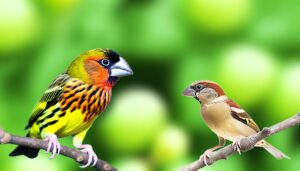3 Key Differences Between Baby Starlings and Sparrows
You'll spot baby starlings by their larger size, elongated body, and darker plumage. They have a slender, pointed beak with a yellowish base.
Baby sparrows, in contrast, are smaller, stockier, and sport defined streaks and spots on lighter plumage with a pinkish or grayish conical beak. Starlings weigh more, ranging from 60-80 grams, compared to sparrows at 20-30 grams.
In vocalization, starlings produce complex, varied sounds, whereas sparrows use simpler, repetitive calls. Starlings prefer nesting in cavities, while sparrows opt for open spaces.
These distinctions highlight fascinating differences that will enrich your understanding further.
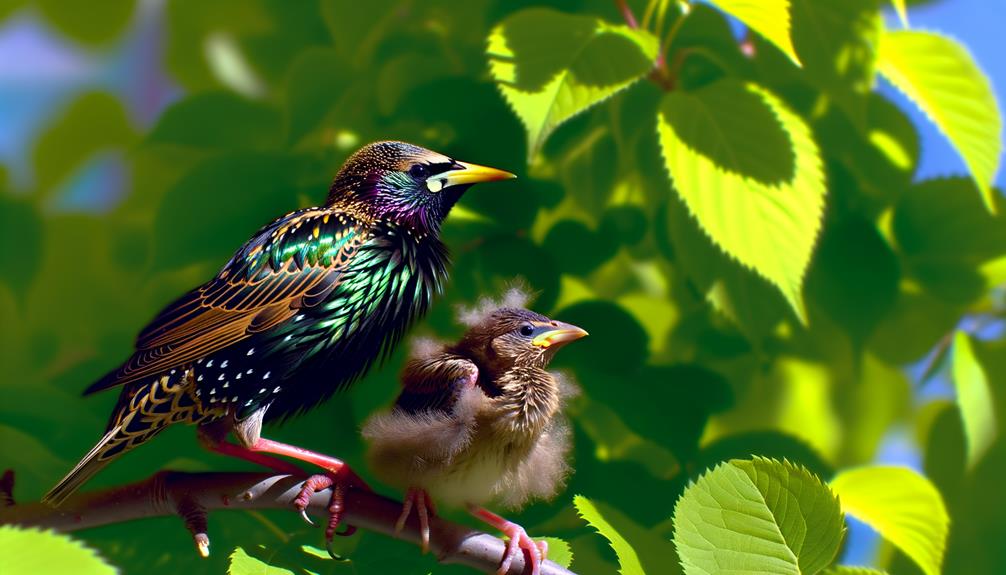
Key Takeaways
- Baby starlings have an elongated body and slender, pointed beak, while baby sparrows are stockier with a stout, conical beak.
- Baby starlings exhibit darker plumage without mottled patterns, whereas baby sparrows have lighter coloration with defined streaks and spots.
- Baby starlings weigh 60-80 grams and are 16-22 cm long; baby sparrows weigh 20-30 grams and are 12-14 cm long.
- Baby starlings produce complex, varied sounds; baby sparrows have simpler, repetitive calls.
- Starlings nest in cavities and use meticulous layering; sparrows prefer open spaces and focus on compact nest building.
Physical Appearance
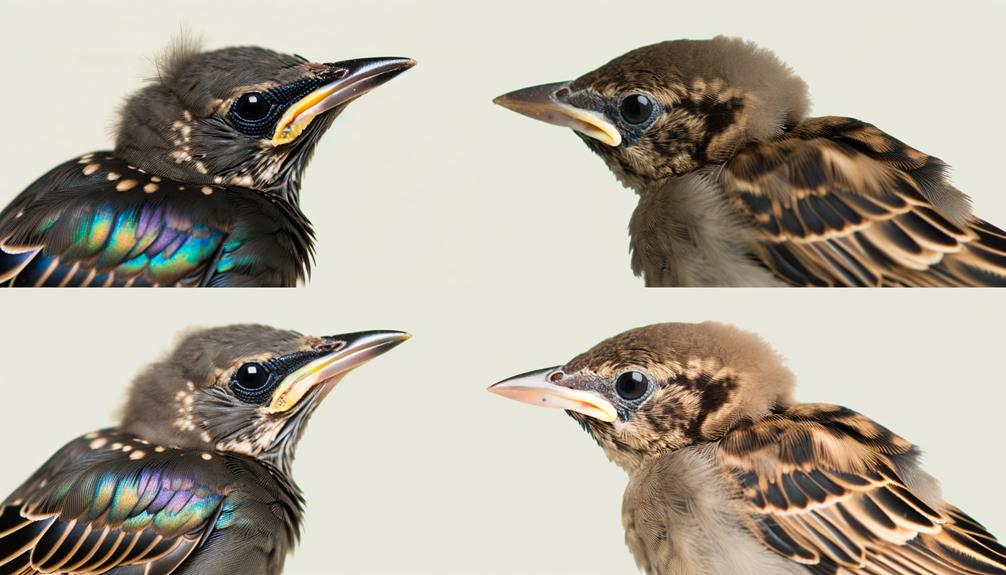
When comparing the physical appearance of baby starlings and sparrows, you'll notice distinct differences in their plumage and size.
Baby starlings typically exhibit a more elongated body and slightly larger size compared to baby sparrows. Their plumage is generally darker and more uniform, lacking the mottled patterns seen in baby sparrows.
Additionally, baby starlings have a more pronounced gape flange, which is the brightly colored area at the corners of their beaks. In contrast, baby sparrows have a stockier build and lighter, more varied coloration. Their heads are proportionally larger relative to their bodies.
Feather Patterns
Examining the feather patterns of baby starlings and sparrows reveals important distinctions that aid in their identification and understanding.
Baby starlings exhibit a mostly dull, brownish-gray plumage with a subtle speckling effect, lacking distinct markings. In contrast, baby sparrows display more defined streaks and spots across their body, particularly on the chest and back, where you'll notice a pattern of fine, dark lines against a lighter background.
The sparrows' feathers also tend to be more uniform in texture compared to the slightly fluffier appearance of starling chicks.
Beak Shape
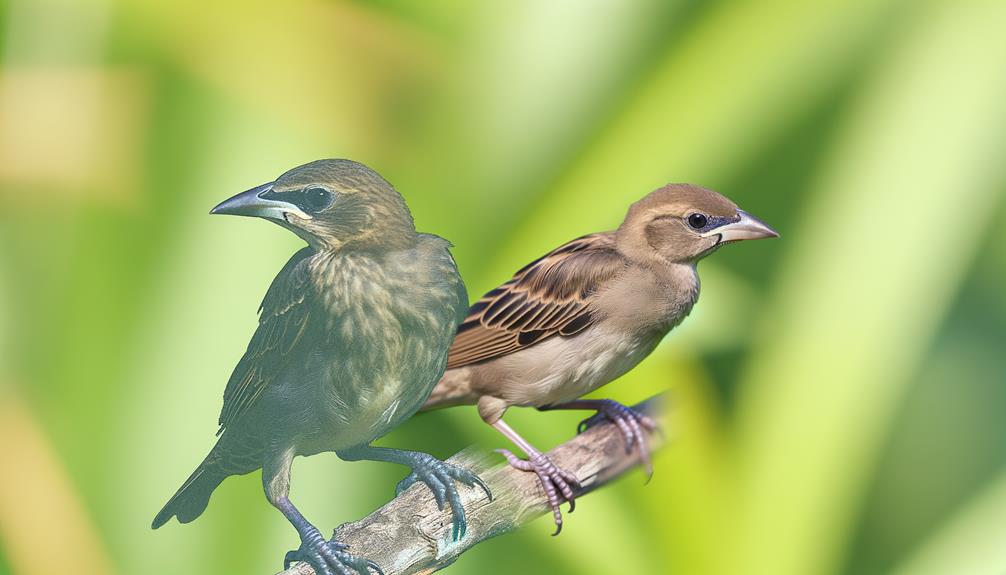
In addition to feather patterns, beak shape provides another key characteristic for distinguishing between baby starlings and sparrows. By focusing on the beak's morphology, you can make an accurate identification.
- Baby Starlings: Display a slender, pointed beak, ideal for their diet of insects and fruits.
- Baby Sparrows: Exhibit a stout, conical beak, suited for cracking seeds.
- Coloration: Baby starlings often have a yellowish base to their beak, while baby sparrows generally have a pinkish or grayish hue.
- Growth Stages: The beak shape of starlings elongates more noticeably as they mature compared to the relatively stable shape of sparrow beaks.
Understanding these distinctions can help you better serve and protect these young birds in their natural habitats.
Size and Weight
You'll notice that baby starlings are generally larger and heavier than baby sparrows, making size and weight another clear differentiator between these species. This difference is pivotal when you're identifying and caring for these birds. Baby starlings exhibit a more robust physique, often weighing between 60-80 grams, whereas baby sparrows typically weigh around 20-30 grams.
Here's a concise comparison:
| Feature | Baby Starling | Baby Sparrow |
|---|---|---|
| Average Weight | 60-80 grams | 20-30 grams |
| Body Length | 16-22 cm | 12-14 cm |
| Wing Span | 30-35 cm | 20-25 cm |
These metrics not only aid in identification but also inform feeding and habitat requirements, ensuring you provide the best care for each species.
Vocalizations
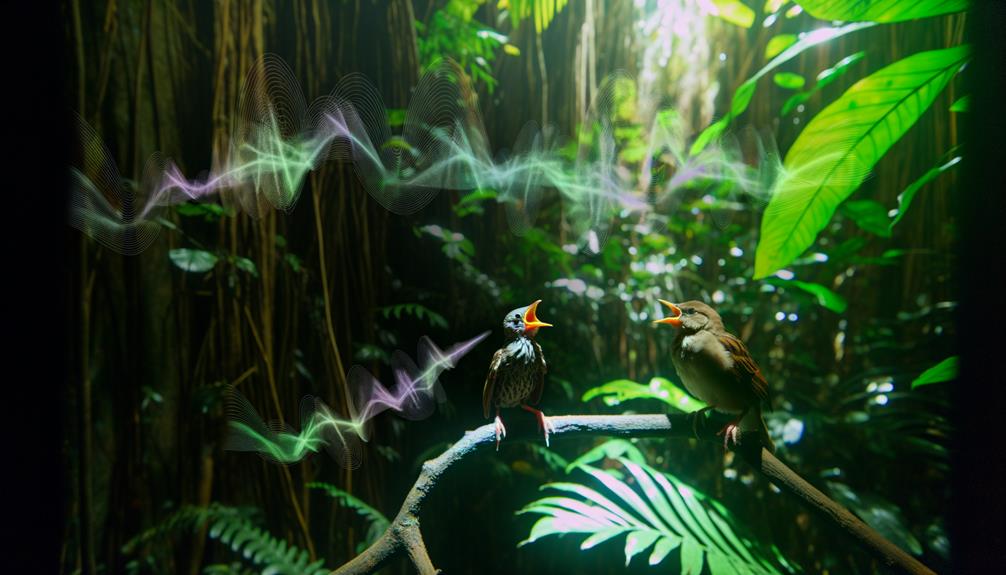
When you compare the vocalizations of baby starlings and sparrows, you'll notice distinct call patterns that differentiate the species.
Baby starlings exhibit a complex range of sounds and are adept at learning song mimicry from their surroundings.
In contrast, baby sparrows produce simpler, more repetitive calls and don't mimic other bird songs as effectively.
Distinctive Call Patterns
Unlike baby sparrows, whose vocalizations are relatively simple and repetitive, baby starlings exhibit a more varied and complex range of call patterns that frequently mimic other birds and environmental sounds.
You'll notice that baby starlings produce a rich tapestry of sounds, making their calls more intricate and unpredictable. This complexity can be attributed to their advanced vocal apparatus and heightened auditory sensitivity.
Key observations include:
- Variety in pitch: Baby starlings utilize a wide range of frequencies, unlike the more monotone sparrows.
- Mimicry: They often imitate sounds from their surroundings, adding layers to their vocal repertoire.
- Rhythmic diversity: Their calls feature varying rhythms and cadences.
- Volume fluctuation: Noticeable changes in loudness make their calls dynamic.
This complex vocal behavior aids in early social interactions and environmental adaptation.
Learning Song Mimicry
Building on the intricate call patterns, baby starlings develop their remarkable vocalizations through a sophisticated process of learning song mimicry. They listen intently to a variety of sounds in their environment, including other birds, human speech, and ambient noises. These young starlings then practice and refine these sounds, creating a broad repertoire.
In contrast, baby sparrows rely more heavily on innate vocalizations, with less emphasis on mimicry. Their songs are primarily inherited, though some environmental tuning occurs. By understanding these differences, you can better appreciate and support the unique learning processes of these birds.
Encouraging diverse soundscapes benefits starlings' mimicry skills, while consistency aids sparrows in perfecting their natural songs.
Feeding Habits
When observing feeding habits, you'll notice that baby starlings primarily consume insects, whereas baby sparrows have a more varied diet including seeds and insects.
Starlings require more frequent feeding intervals compared to sparrows due to their higher metabolic rate.
Additionally, both starling parents share feeding responsibilities, while sparrow feeding roles often differ, with the female typically taking the lead.
Dietary Preferences
Both baby starlings and sparrows exhibit distinct dietary preferences that reflect their species-specific nutritional needs and foraging behaviors.
You'll find that baby starlings primarily consume a diet rich in animal proteins, an adaptation that supports their rapid growth and development. They often eat:
- Insects such as caterpillars, beetles, and spiders
- Small invertebrates found in soil and foliage
- Soft fruits like berries to supplement their protein intake
- Cultivated grains when insects are scarce
In contrast, baby sparrows have a more varied diet that includes both plant and animal matter. They primarily feed on:
- Seeds and grains for their carbohydrate needs
- Insects for essential proteins and fats
- Green plant materials for vitamins and minerals
- Bread crumbs and other human-provided foods, especially in urban areas
Feeding Frequency
Understanding the feeding frequency of baby starlings and sparrows reveals significant differences in their growth patterns and parental care strategies.
Baby starlings require more frequent feedings, often every 20-30 minutes, to support rapid growth and high metabolic rates. This intense feeding schedule demands substantial parental effort and vigilance.
In contrast, baby sparrows are fed less frequently, approximately every 1-2 hours, reflecting a slower growth rate and different energy needs.
By observing these patterns, you'll notice that starlings exhibit a high-demand approach, ensuring swift fledging, while sparrows adopt a more measured strategy.
Providing appropriate feeding frequencies for each species safeguards their well-being and developmental success, highlighting the intricate balance nature maintains in nurturing its young.
Parental Feeding Roles
Examining the parental feeding roles reveals how starlings and sparrows allocate responsibilities and develop distinct feeding habits to secure their offspring's survival.
In starlings, both parents are actively involved in feeding their chicks, ensuring a balanced distribution of food. Starlings share feeding duties equally, enhancing resource delivery efficiency.
Sparrows, on the other hand, exhibit a more defined division of labor where the female primarily broods the young while the male focuses on foraging. Males mainly forage, allowing females to concentrate on brooding and protecting the nest.
Key observations include:
- Starlings: Both parents share feeding duties equally, enhancing resource delivery efficiency.
- Sparrows: Males mainly forage, allowing females to concentrate on brooding and protecting the nest.
Diet Variability: Starlings provide a mixture of insects and fruits, whereas sparrows mainly offer seeds and insects.
Feeding Frequency: Starlings tend to feed more frequently compared to sparrows, reflecting different energetic demands.
Understanding these roles can help in targeted conservation efforts.
Nesting Behavior
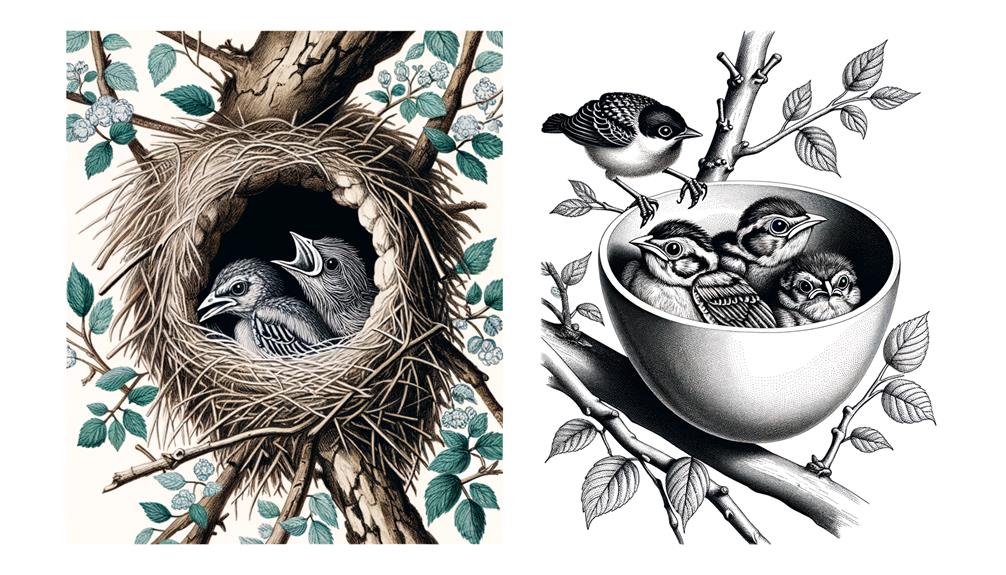
In observing the nesting behavior of baby starlings and sparrows, you'll notice distinct differences in their choice of nesting sites and construction techniques.
Starlings often opt for cavities in trees or man-made structures, crafting their nests using grass, feathers, and twigs. Sparrows, on the other hand, prefer more open spaces like shrubs or eaves of buildings. They construct their nests using a combination of grass, paper, and feathers, creating a well-insulated environment.
Starlings typically exhibit meticulous layering, whereas sparrows focus on compactness. These variances reflect their adaptations to different ecological niches and survival strategies.
Preferred Habitats
Whether it's urban parks or rural fields, baby starlings and sparrows each show distinct preferences for their habitats, reflecting their unique ecological adaptations.
You'll find baby starlings mainly in areas with abundant human activity. They thrive in open spaces like parks and gardens where they can readily access food.
In contrast, baby sparrows favor more secluded environments. They're often found in hedgerows, brushy fields, and agricultural landscapes where protective cover and nesting sites abound.
Consider these habitat distinctions:
- Urban Environments: Starlings frequent bustling city parks.
- Suburban Gardens: Both species can be observed, but starlings are dominant.
- Agricultural Fields: Sparrows find refuge and sustenance here.
- Natural Brushlands: Sparrows excel in these protective habitats.
Understanding these preferences helps in creating environments that support their growth and survival.
Conclusion
In comparing baby starlings and sparrows, you'll notice that starlings are generally larger and have distinctive speckled feathers, while baby sparrows are smaller with more uniform plumage.
Surprisingly, baby starlings can consume up to 50% of their body weight in insects daily, showcasing their voracious appetite.
By observing their unique beak shapes, vocal patterns, and nesting behaviors, you can accurately identify each species and appreciate their distinct ecological roles and adaptations.



